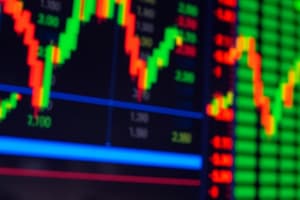Podcast
Questions and Answers
What is the primary function of market makers in the Forex market?
What is the primary function of market makers in the Forex market?
- To provide liquidity (correct)
- To regulate trading hours
- To manage risk
- To set exchange rates
What type of risk is associated with the possibility of a counterparty defaulting on a trade?
What type of risk is associated with the possibility of a counterparty defaulting on a trade?
- Market risk
- Operational risk
- Liquidity risk
- Credit risk (correct)
Which of the following is a characteristic of the Forex market?
Which of the following is a characteristic of the Forex market?
- No leverage available
- Low liquidity
- Fixed trading hours
- High leverage available (correct)
What is the primary goal of risk management in trading?
What is the primary goal of risk management in trading?
What type of currency pair is EUR/JPY?
What type of currency pair is EUR/JPY?
What is the purpose of a stop-loss order in trading?
What is the purpose of a stop-loss order in trading?
What is the primary focus of technical analysis in trading?
What is the primary focus of technical analysis in trading?
Which of the following is a technical analysis tool used to identify trends?
Which of the following is a technical analysis tool used to identify trends?
What is a key characteristic of an algorithm?
What is a key characteristic of an algorithm?
What is the primary goal of pattern recognition in computational thinking?
What is the primary goal of pattern recognition in computational thinking?
What is involved in the decoding process?
What is involved in the decoding process?
What is a debugging technique used to identify errors in a program?
What is a debugging technique used to identify errors in a program?
What is the primary purpose of abstraction in computational thinking?
What is the primary purpose of abstraction in computational thinking?
Which of the following is NOT a characteristic of an algorithm?
Which of the following is NOT a characteristic of an algorithm?
What is the relationship between pattern recognition and data analysis?
What is the relationship between pattern recognition and data analysis?
What is the primary goal of debugging in computational thinking?
What is the primary goal of debugging in computational thinking?
Flashcards are hidden until you start studying
Study Notes
Forex Trading
- Definition: Forex trading, also known as FX trading, is the exchange of one country's currency for another country's currency at an agreed-upon exchange rate.
- Key players:
- Retail traders (individuals)
- Institutional traders (banks, hedge funds, etc.)
- Market makers (dealers who provide liquidity)
- Market characteristics:
- Largest and most liquid market in the world
- 24/5 trading hours (Monday to Friday)
- High leverage (up to 1:500) available
- Volatile market with high price fluctuations
- Currency pairs:
- Major pairs (e.g. EUR/USD, USD/JPY)
- Minor pairs (e.g. EUR/JPY, GBP/CHF)
- Exotic pairs (e.g. USD/TRY, EUR/MXN)
Risk Management
- Definition: Risk management is the process of identifying, assessing, and mitigating potential losses in trading.
- Types of risk:
- Market risk (price movements)
- Liquidity risk ( inability to enter or exit trades)
- Credit risk (default by counterparty)
- Operational risk (human error, system failure)
- Risk management strategies:
- Position sizing (adjusting trade size to manage risk)
- Stop-loss orders (automatically closing losing trades)
- Diversification (spreading risk across multiple assets)
- Hedging (reducing risk by taking opposite positions)
- ** IMPORTANCE**: Risk management is crucial to trading success, as it helps to minimize losses and maximize returns.
Technical Analysis
- Definition: Technical analysis is a method of evaluating securities by analyzing statistical patterns and trends in price and volume data.
- Key concepts:
- Charts and patterns (e.g. trends, support and resistance, candlestick patterns)
- Indicators (e.g. moving averages, relative strength index, Bollinger Bands)
- Trends (up, down, sideways)
- Technical analysis tools:
- Charts (line, bar, candlestick)
- Oscillators (e.g. RSI, Stochastic Oscillator)
- Trend indicators (e.g. Moving Averages, MACD)
- Assumptions:
- Markets are efficient, and prices reflect all available information
- Prices move in trends and patterns
- History repeats itself, and patterns can be used to predict future price movements
Forex Trading
- Forex trading is the exchange of one country's currency for another country's currency at an agreed-upon exchange rate.
- Key players in the forex market include retail traders, institutional traders, and market makers.
- The forex market is the largest and most liquid market in the world, with 24/5 trading hours from Monday to Friday.
- High leverage of up to 1:500 is available in the forex market.
- The forex market is highly volatile, with high price fluctuations.
Currency Pairs
- Currency pairs are categorized into major pairs, minor pairs, and exotic pairs.
- Major pairs include EUR/USD and USD/JPY.
- Minor pairs include EUR/JPY and GBP/CHF.
- Exotic pairs include USD/TRY and EUR/MXN.
Risk Management
- Risk management is the process of identifying, assessing, and mitigating potential losses in trading.
- Types of risk in trading include market risk, liquidity risk, credit risk, and operational risk.
- Market risk refers to the risk of losses due to price movements.
- Liquidity risk refers to the inability to enter or exit trades.
- Credit risk refers to the risk of default by a counterparty.
- Operational risk refers to the risk of human error or system failure.
Risk Management Strategies
- Position sizing is a risk management strategy that involves adjusting trade size to manage risk.
- Stop-loss orders are a risk management strategy that involves automatically closing losing trades.
- Diversification is a risk management strategy that involves spreading risk across multiple assets.
- Hedging is a risk management strategy that involves reducing risk by taking opposite positions.
- Risk management is crucial to trading success, as it helps to minimize losses and maximize returns.
Technical Analysis
- Technical analysis is a method of evaluating securities by analyzing statistical patterns and trends in price and volume data.
- Key concepts in technical analysis include charts and patterns, indicators, and trends.
- Charts and patterns include trends, support and resistance, and candlestick patterns.
- Indicators include moving averages, relative strength index, and Bollinger Bands.
- Trends can be up, down, or sideways.
Technical Analysis Tools
- Charts are a technical analysis tool that can be line, bar, or candlestick.
- Oscillators are a technical analysis tool that includes RSI and Stochastic Oscillator.
- Trend indicators are a technical analysis tool that includes Moving Averages and MACD.
Assumptions of Technical Analysis
- The market is efficient, and prices reflect all available information.
- Prices move in trends and patterns.
- History repeats itself, and patterns can be used to predict future price movements.
Computational Thinking
- Breaks down complex problems into manageable parts
- Involves analyzing data and developing solutions using computational tools and techniques
Algorithms
- A step-by-step procedure for solving a problem or achieving a goal
- Can be expressed in various forms, such as natural language, flowcharts, or programming languages
- Must have four key characteristics:
- Finiteness: eventually stops
- Definiteness: each step is precisely defined
- Effectiveness: can be carried out by a computer
- Efficiency: uses minimal resources
Pattern Recognition
- Identifies and describes patterns in data
- Patterns can be visual, numerical, or structural
- Essential for data analysis, predictive modeling, and decision-making
Decoding
- Extracts meaning from encoded data or information
- Involves identifying the encoding scheme, translating the data, and interpreting the result
- Crucial for data compression, encryption, communication protocols, and error detection
Debugging
- Identifies and fixes errors or bugs in a program or system
- Involves identifying the source of the error, isolating the problem, and developing a solution
- Techniques include print statements, breakpoints, code reviews, and testing
Abstraction
- Represents complex systems or concepts in a simplified form
- Involves focusing on essential features, ignoring irrelevant details, and creating a model
- Essential for problem-solving, modeling, communication, collaboration, scalability, and complexity management
Studying That Suits You
Use AI to generate personalized quizzes and flashcards to suit your learning preferences.




